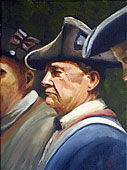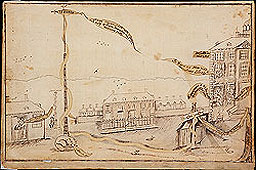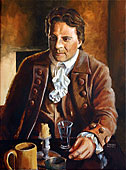For Teachers: Lessons
Lesson 1: Prologue: A Revolutionary People
Learning Objectives
After completing this lesson, students will be able to:
- Describe the American people’s legacy of confrontation with the British
- Compare and contrast the political views of Whigs and Loyalists
- Explain the significance of the Boston Tea Party
- Explain the significance of the Massachusetts Government Act
- Describe what happened with the Liberty Pole and its significance
- Explain the significance of the Massachusetts Provincial Congress
Skills
- Interpreting visual information
- Observing and describing
- Thinking critically
- Expressing opinions
- Analyzing visually
- Understanding historical perspective
- Gathering and using information
- Interpreting information
Introduction
In this lesson, students learn that like the other states, Massachusetts had participated in a radicalizing event: the American Revolution. In the years leading up to war and then independence, communities throughout Massachusetts experienced turmoil and often violence as resistance to British government and authority intensified.
 |
 |
 |
| Moses Harvey, © 2008 Bryant White | Liberty Pole, Courtesy of the Library Company of Philadelphia, Philadelphia, PA | Seth Catlin, © 2008 Bryant White |
Guiding Concepts
In western Massachusetts as elsewhere, families and communities fractured under rising political pressure and conflict as the British government tightened up oversight and administration of its colonies following the successful conclusion of the French and Indian War. Whigs and Loyalists sparred with each other; Liberty men celebrated the dumping of tea in Boston Harbor; conservatives condemned the destruction of property and mourned the breakdown of law and order. The British Parliament passed The Massachusetts Government Act, and widespread, organized resistance erupted across Massachusetts. Debates over what seemed to be irreconcilable differences escalated, and militias began drilling on town training fields, prepared to fight for the rights and liberties of the people that more and more Americans believed would need to be defended by force.
Preparing to Teach
- Familiarize yourself with the Prologue: A Revolutionary People historic scene, linked to from the Historic Scene menu.
- Familiarize yourself with the Massachusetts Government Act in the Glossary.
- Familiarize yourself with the four essays for War’s End and the six Everyday Life essays in the Themes and Essays section.
- Familiarize yourself with the Library of Congress’ Using Primary Resources.
- Although not explicitly referred to in the lesson, you can incorporate selections from the Timeline and Music section into the lesson.
Teaching the Lesson
- Class Assignment: Prior to the class period spent on this lesson, make the following website preparation assignment:
- Go to the Prologue: A Revolutionary People historic scene from the Historic Scene menu. Read it through, following the links and reading what displays.
- Read the four essays for War’s End and the six Everyday Life essays in the Themes and Essays section.
- Assign each of the following characters to a student (or a small group of students) so the student(s) can assume that historic persona in class: Elihu Ashley, Moses Harvey, and Seth Catlin. The character narratives are found in the People menu.
- Class Activity: History Through the Eyes of Those Who Lived It: History comes alive when you experience it through the lives of the people who lived it. Studying the lives of Seth Catlin, Dr. Elihu Ashley, and Moses Harvey provides a glimpse into this period of American History from both the Loyalist and Whig persuasions. Excerpts from Ashley’s journal further provide a commentary on the period and a sense of the tension and violence that characterized it. For example, excerpts can be found by searching the Artifacts and Documents section using an Item Type of “Manuscripts” and a keyword of “Ashley.”
- Gather the Moses Harvey personas on one side of the room and the Seth Catlin and Elihu Ashley personas on the other. On a white or black board, write each persona’s name at the top with a vertical line separating them. Ask students to list the feelings, concerns, issues, and thoughts of each historic character. Engage the class in a discussion of similarities and differences.
- Class Activity: What’s in a Picture?: Project the image of the Liberty Pole onto a screen. The image can be found by searching the Artifacts and Documents section using an Item Type of “All Types ” and keywords of “liberty pole.” Zoom in on the picture and ask students about various aspects of the drawing: the caption on the flag at the top of the pole (I am encompased with a ton and half of Iron. Therefore can't relieve thee); the text coming out of the mouth of the man in the window in the lower left corner (“a fine prospect of liberty”); the text coming out of the mouth of the person in the window on the right (Is there no other road to thee Sweet Liberty), and the man on the ground to the right of the pole (“all is well”). Discuss the meaning of the sentiments and who might be expressing them. Frame the discussion in light of the Liberty Pole story in the character narratives of Seth Catlin and Elihu Ashley.
- Class Discussion Questions:
- What sorts of resistance to government occurred in Massachusetts in the 1770s? Compare this activity to the actions of the Massachusetts Regulators in 1786-87. In what ways are they similar? In what ways do they differ?
- What were the circumstances of the Boston Tea Party? What was its significance?
- What were the provisions of the Massachusetts’ Government Act? (One of a series of so-call Intolerable, or Coercive Acts passed by the British Parliament in 1774, it gave control of the judicial courts to the royal governor and severely limited the actions and jurisdiction of town meetings throughout the colony.)
- What was the significance of the Liberty Pole? Who erected it? Who cut it down and why?
- Who was closing courts and why? (Moses Harvey and other “Liberty Men) What action did the closing of courts in 1774 portend? (Closing of courts in 1786 in Massachusetts)
- What was the Massachusetts Provisional Congress? (a shadow government opposed to the “intolerable grievances and oppression to which the people are subjected…”)
Additional Resources
Books and Articles
- Gross, Robert, ed. In Debt to Shays: The Bicentennial of an Agrarian Rebellion, volume 65. Boston, MA: The Colonial Society of Massachusetts, 1993.
- Richards, Leonard. Shays’s Rebellion: The American Revolution’s Final Battle. Philadelphia: University of Pennsylvania Press, 2002.
- Starkey, Marion. A Little Rebellion. New York: Knopf, 1955.
- Satzmary, David. Shays’ Rebellion: The Making of an Agrarian Insurrection. Amherst, MA: University of Massachusetts Press, 1980.
Websites
- Library of Congress-Historian's Sources: Using Primary Resources
- Library of Congress: Digital Resources Related to the American Revolution
- Library of Congress: American Memory
- Shay’s Rebellion Song
- Best of History Websites: American Revolution and Independence
- PBS: Liberty: The American Revolution
- NEH Edsitement: History and Social Studies
- James Madison Center: US History Curricula
- History Institute, University of Massachusetts: Shays’ Rebellion and Related Resources
Movies
- The History Channel Series: 10 Days That Changed America: Shays’ Rebellion: America’s First Civil War; 60 minutes
- Calliope: A little Rebellion Now and Then: Prologue to the Constitution; 30 minutes